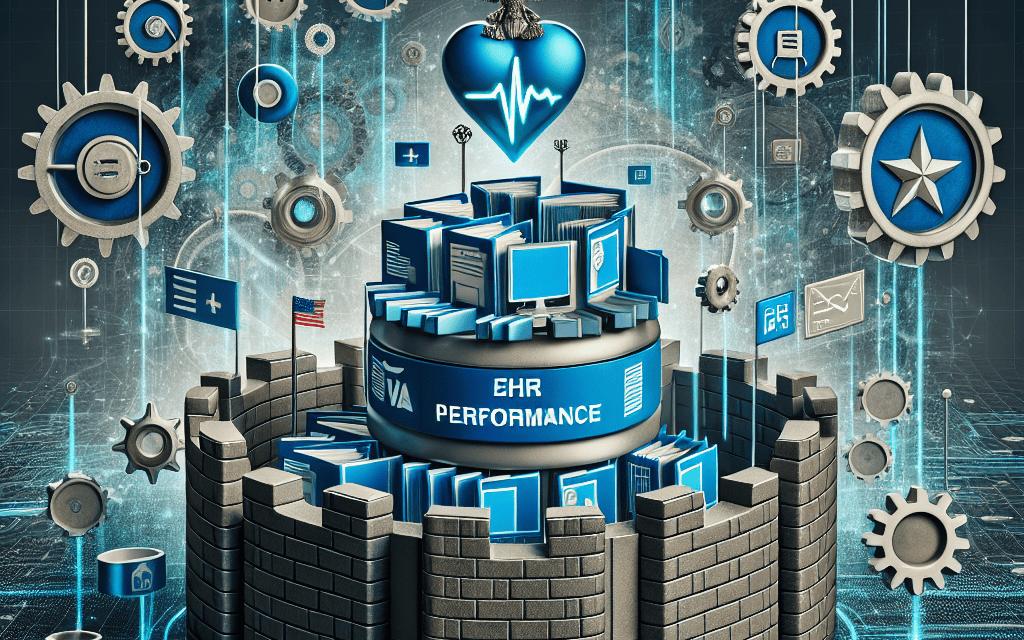Enhancing EHR Performance: Strengthening VA’s Control Measures

The Veterans Affairs (VA) healthcare system is one of the largest integrated healthcare systems in the United States, serving millions of veterans across the country. A critical component of this system is the Electronic Health Record (EHR), which plays a pivotal role in managing patient information, streamlining care, and improving outcomes. However, the performance of EHR systems can be hindered by various challenges, necessitating robust control measures to enhance their efficiency and effectiveness. This article delves into the strategies for enhancing EHR performance within the VA, focusing on strengthening control measures to ensure optimal functionality and security.
Understanding the Current EHR Landscape in the VA
The VA’s EHR system, known as VistA (Veterans Health Information Systems and Technology Architecture), has been a cornerstone of veteran healthcare for decades. However, as technology evolves, so do the demands on EHR systems. Understanding the current landscape is crucial for identifying areas that require improvement.
The Evolution of VistA
VistA was developed in the late 1970s and has undergone numerous updates to meet the changing needs of healthcare delivery. Despite its longevity, VistA faces challenges such as outdated technology, interoperability issues, and user dissatisfaction. These challenges have prompted the VA to embark on a modernization journey, transitioning to a new EHR system known as Cerner Millennium.
The transition to Cerner Millennium aims to address the limitations of VistA by providing a more integrated and user-friendly platform. However, this transition is not without its challenges, including data migration, training, and ensuring continuity of care during the switch.
Challenges in EHR Performance
Several factors contribute to suboptimal EHR performance within the VA:
- Interoperability Issues: The inability of different EHR systems to communicate effectively can lead to fragmented care and data silos.
- User Interface Complexity: A complex and non-intuitive user interface can hinder healthcare providers’ ability to efficiently navigate the system.
- Data Security Concerns: Protecting sensitive patient information is paramount, yet EHR systems are often targeted by cyber threats.
- System Downtime: Frequent system outages can disrupt care delivery and lead to delays in treatment.
Addressing these challenges requires a comprehensive approach that strengthens control measures and enhances EHR performance.
Implementing Robust Data Security Measures
Data security is a critical aspect of EHR performance, particularly within the VA, where sensitive patient information is stored and accessed. Implementing robust security measures is essential to protect against data breaches and ensure patient confidentiality.
Encryption and Access Controls
Encryption is a fundamental security measure that ensures data is unreadable to unauthorized users. By encrypting data both at rest and in transit, the VA can significantly reduce the risk of data breaches. Additionally, implementing strict access controls ensures that only authorized personnel can access sensitive information.
Access controls can be enhanced through multi-factor authentication (MFA), which requires users to provide multiple forms of verification before accessing the system. This adds an extra layer of security and reduces the likelihood of unauthorized access.
Regular Security Audits and Monitoring
Conducting regular security audits is essential for identifying vulnerabilities within the EHR system. These audits should be comprehensive, covering all aspects of the system, including hardware, software, and network infrastructure. By identifying and addressing vulnerabilities promptly, the VA can prevent potential security breaches.
In addition to audits, continuous monitoring of the EHR system is crucial for detecting suspicious activity in real-time. Implementing advanced monitoring tools and intrusion detection systems can help identify and mitigate threats before they escalate.
Training and Awareness Programs
Human error is a significant factor in data breaches, making training and awareness programs vital components of data security. The VA should implement regular training sessions for all staff members, focusing on best practices for data security and the importance of safeguarding patient information.
These programs should also emphasize the importance of reporting suspicious activity and potential security incidents promptly. By fostering a culture of security awareness, the VA can empower its staff to play an active role in protecting patient data.
Enhancing Interoperability and Data Sharing
Interoperability is a key factor in enhancing EHR performance, as it enables seamless data sharing between different healthcare systems. For the VA, improving interoperability is essential for providing coordinated care to veterans who may receive treatment from multiple providers.
Adopting Standardized Data Formats
One of the primary barriers to interoperability is the use of disparate data formats across different EHR systems. By adopting standardized data formats, such as HL7 FHIR (Fast Healthcare Interoperability Resources), the VA can facilitate seamless data exchange between its EHR system and those of other healthcare providers.
Standardized data formats ensure that information is consistently structured, making it easier to share and interpret across different systems. This not only improves care coordination but also enhances the accuracy and completeness of patient records.
Building Collaborative Partnerships
Collaboration with other healthcare organizations is crucial for enhancing interoperability. The VA should actively engage in partnerships with other healthcare providers, government agencies, and technology vendors to develop and implement interoperability solutions.
These partnerships can facilitate the exchange of best practices, resources, and expertise, ultimately leading to more effective interoperability solutions. By working together, stakeholders can address common challenges and develop innovative approaches to data sharing.
Leveraging Health Information Exchanges (HIEs)
Health Information Exchanges (HIEs) play a vital role in facilitating data sharing between different healthcare systems. By participating in HIEs, the VA can access a broader network of patient information, enabling more comprehensive and coordinated care.
HIEs provide a platform for exchanging patient data securely and efficiently, reducing the need for manual data entry and minimizing the risk of errors. By leveraging HIEs, the VA can enhance its ability to deliver timely and informed care to veterans.
Optimizing User Experience and Interface Design
The user experience (UX) and interface design of an EHR system significantly impact its performance and usability. A well-designed interface can streamline workflows, reduce errors, and improve user satisfaction, ultimately enhancing the overall performance of the EHR system.
Conducting User-Centered Design Processes
User-centered design (UCD) is an approach that involves actively engaging end-users in the design process to ensure that the final product meets their needs and expectations. By involving healthcare providers in the design of the EHR system, the VA can create an interface that is intuitive and easy to navigate.
UCD processes typically involve conducting user interviews, surveys, and usability testing to gather feedback and identify areas for improvement. This iterative approach ensures that the EHR system is continuously refined based on user input, leading to a more user-friendly interface.
Streamlining Workflows and Reducing Clicks
One of the common complaints about EHR systems is the number of clicks required to complete tasks. Streamlining workflows and reducing unnecessary clicks can significantly enhance the user experience and improve efficiency.
The VA can achieve this by conducting workflow analyses to identify bottlenecks and areas where tasks can be automated or simplified. By optimizing workflows, healthcare providers can spend less time navigating the system and more time focusing on patient care.
Providing Comprehensive Training and Support
Even the most well-designed EHR system requires comprehensive training and support to ensure that users can effectively utilize its features. The VA should implement robust training programs that cover all aspects of the EHR system, from basic navigation to advanced functionalities.
In addition to initial training, ongoing support is essential for addressing user questions and issues as they arise. Providing access to a dedicated support team and resources, such as user manuals and online tutorials, can help users feel confident and competent in using the EHR system.
Ensuring System Reliability and Reducing Downtime
System reliability is a critical factor in EHR performance, as downtime can disrupt care delivery and lead to delays in treatment. Ensuring that the EHR system is reliable and available when needed is essential for maintaining continuity of care.
Implementing Redundancy and Backup Systems
Redundancy and backup systems are essential components of a reliable EHR system. By implementing redundant servers and backup systems, the VA can ensure that patient data is protected and accessible even in the event of a system failure.
These systems should be regularly tested to ensure that they function as intended and can be quickly activated in the event of an outage. By having robust redundancy and backup systems in place, the VA can minimize the impact of downtime on patient care.
Conducting Regular Maintenance and Updates
Regular maintenance and updates are crucial for ensuring that the EHR system remains reliable and up-to-date. The VA should establish a schedule for routine maintenance, including software updates, hardware checks, and system optimizations.
By keeping the EHR system current, the VA can address potential issues before they escalate and ensure that the system continues to meet the needs of healthcare providers and patients.
Monitoring System Performance and Addressing Issues Promptly
Continuous monitoring of system performance is essential for identifying and addressing issues before they impact care delivery. The VA should implement advanced monitoring tools that provide real-time insights into system performance and alert administrators to potential problems.
By addressing issues promptly, the VA can prevent system outages and ensure that the EHR system remains reliable and available when needed. This proactive approach to system management is essential for maintaining continuity of care and enhancing EHR performance.
Conclusion
Enhancing EHR performance within the VA is a multifaceted endeavor that requires a comprehensive approach to strengthening control measures. By implementing robust data security measures, enhancing interoperability, optimizing user experience, and ensuring system reliability, the VA can improve the efficiency and effectiveness of its EHR system.
These strategies not only enhance the performance of the EHR system but also contribute to better patient outcomes and improved care delivery for veterans. As the VA continues its journey towards EHR modernization, it is essential to prioritize these control measures to ensure that the system meets the evolving needs of healthcare providers and patients alike.
Ultimately, by strengthening control measures and enhancing EHR performance, the VA can fulfill its mission of providing high-quality, coordinated care to veterans across the country.





